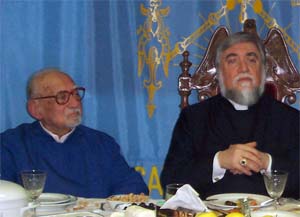 pictured here with the Catholicos at the biennial gathering of the
brotherhood in January. The funeral litugry was rich in symbol and ceremony, a
solemn leave taken full in hope and grace. The Divine Liturgy is celebrated at
the funeral of a priest or bishop, and features the final annointing of the
body, a cross signed in holy Miron (oil) on the forhead and right hand. Photos
of the annointing are available on the website of the Catholicosate. Click
here.
pictured here with the Catholicos at the biennial gathering of the
brotherhood in January. The funeral litugry was rich in symbol and ceremony, a
solemn leave taken full in hope and grace. The Divine Liturgy is celebrated at
the funeral of a priest or bishop, and features the final annointing of the
body, a cross signed in holy Miron (oil) on the forhead and right hand. Photos
of the annointing are available on the website of the Catholicosate. Click
here.
Following the interment of the casket in the underground vault reserved for
members of the brotherhood, we adjourn to the the Great Hall in the residence of
the Catholicos. There, many come by to express their condolences, and time is
taken for reminiscing about the life of the departed Serpazan.
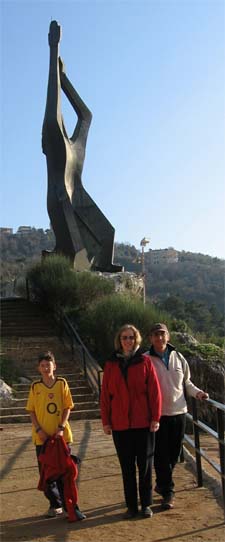 Bishop Ghevont was in the very first class
to graduate, in 1934, from the seminary here (then located at the Catholicosate
in Antelias.) He was ordained a bishop in 1947, the same year the Catholicos was
born! Fr. Krikor reflects on all of the history represented in the long lifespan
of Ghevont Serpazan … the people he knew and events he witnessed. … nearly a
century!
Bishop Ghevont was in the very first class
to graduate, in 1934, from the seminary here (then located at the Catholicosate
in Antelias.) He was ordained a bishop in 1947, the same year the Catholicos was
born! Fr. Krikor reflects on all of the history represented in the long lifespan
of Ghevont Serpazan … the people he knew and events he witnessed. … nearly a
century!
The seminary van (a Mercedes) is packed to its capacity with the 14 deacons and subdeacons, two of the priests from the seminary, and their Canadian ecumenical visitor for the slow climb back up the long hill to Bickfaya in the rain. The weather cycle here is holding true to what Ardavazt Serpazan explained to me a few weeks ago (a couple days of cold rain, followed with 4-6 days of sun.)
The forecast holds true when, the next day — Saturday morning, we awake to
sunshine and what will be a magnificent day. The signs of spring are more and
more abundant: birds singing and the first blossoms and wild flowers (blue bells
and daisies) appearing. I look forward to the afternoon visit of the Shehadi
family, pictured in front of the Genocide monument:
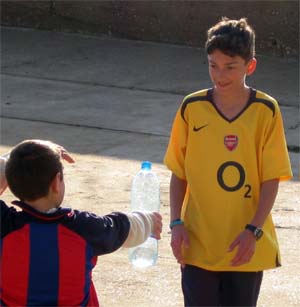 Fr. Nabil, pastor of All Saints Anglican
Church, Beirut, his wife Sarah and their son Sebastian.
Fr. Nabil, pastor of All Saints Anglican
Church, Beirut, his wife Sarah and their son Sebastian.
Fr. Nabil and Sarah had been looking for an opportunity to escape from the madness of the city centre, and Sebastian has been coaxed along with the promise of a chance to play football (i.e. soccer). It doesn’t take long for Sebastian and the junior seminarians, his age, to break the ice and have a good time in the outdoor court. I learned on Saturday, that the departed Ghevont Serpazan himself raised the funds to build the court for the seminarians to enjoy many years ago.
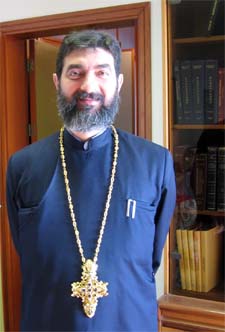 While Sebastian enjoys a game of
football (scoring 5 goals!), we go up to meet Fr. Krikor who, as usual, is hard
at work in his office. Deacon Varoujan, Fr. Krikor’s assistant brings a pot of
cinnamon tea (strained black tea with cinnamon sticks added). Our conversation
comes around to the subject of “crosses” — Fr. Nabil is a collector; and I ask
Fr. Krikor to show us the gold cross his brother Vartan, a jeweller, has
recently fashioned for him. Fr. Krikor is clearly proud of his talented
brother.
While Sebastian enjoys a game of
football (scoring 5 goals!), we go up to meet Fr. Krikor who, as usual, is hard
at work in his office. Deacon Varoujan, Fr. Krikor’s assistant brings a pot of
cinnamon tea (strained black tea with cinnamon sticks added). Our conversation
comes around to the subject of “crosses” — Fr. Nabil is a collector; and I ask
Fr. Krikor to show us the gold cross his brother Vartan, a jeweller, has
recently fashioned for him. Fr. Krikor is clearly proud of his talented
brother.
As planned, we collect Sebastian when the seminarians go off to their weekly choir practice, and we head out for a nice walk in the late afternoon, along a stairway climbing up the mountainside to a village well above the seminary.
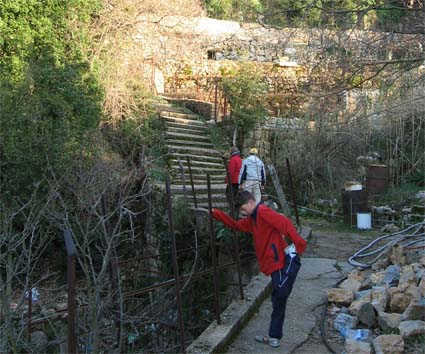
I’ve been doing a lot of exploring during my daily walks in and around the mountain community of Bickfaya, and it’s great to be able to share this recently discovered circuit with the Shehadis! Fr Nabil is delighted to concentrate on taking pictures (all the pictures here from Saturday’s visit are from his camera); Sarah is pleased to gather wild flowers (roots included) to plant in one of the planters on their balcony; and Sebastian is very happy to test the limits of a new set of walkie-talkies he received for his birthday on March 1st.

Fr. Nabil has a lot to choose from in subjects for his photos. The day is
glorious, and the hour growing late with that close-to-sunset warmth of sunlight
cast on the scenery around us.
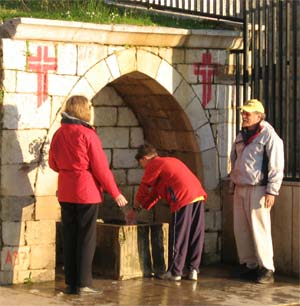 Reaching the village at the top of the steps, we walk by l’Eglise St-Jean
(Maronite), and find our way to the village spring, with fresh mountain water
gushing forth. The climb has made us thirsty and we are happy to pause for a
refreshing drink. Fr. Nabil explains that the red crosses painted on the
stonework represent the worrisome symbol of the Lebanese Forces with the cross
as a dagger. He tells us that the Maronite Patriarch has criticised the use of
this dubious symbol, but Bickfaya being the stronghold of the former Phalangists
militia, the symbol can be spotted throughout the area.
Reaching the village at the top of the steps, we walk by l’Eglise St-Jean
(Maronite), and find our way to the village spring, with fresh mountain water
gushing forth. The climb has made us thirsty and we are happy to pause for a
refreshing drink. Fr. Nabil explains that the red crosses painted on the
stonework represent the worrisome symbol of the Lebanese Forces with the cross
as a dagger. He tells us that the Maronite Patriarch has criticised the use of
this dubious symbol, but Bickfaya being the stronghold of the former Phalangists
militia, the symbol can be spotted throughout the area.
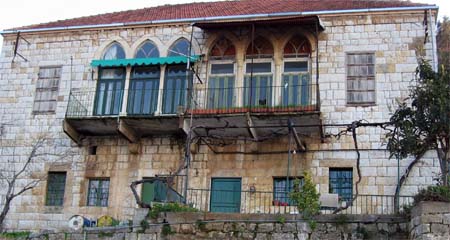
Picking up on Fr. Nabil’s explanation of Lebanese home design (see the post “Steps to Mar Nicholas”, below), Sarah is pleased to discover a duplex (pictured here), with side-by-side triple arched windows opening into the central rooms in each of the two semi-detached dwellings.

Finally, we reach the summit of our walk up through the mountain village, another Maronite church offering a magestic vantage point over the hillside villages below.
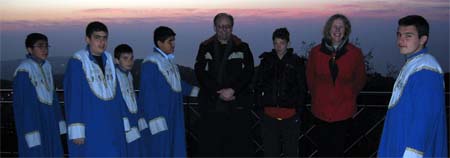
We make our way back down the hill, and its steep stairway, reaching the
seminary as the seminarians begin to gather for Evensong in the Seminary chapel.
 Like the Cathedral, the semainary
chapel is now clothed in its “Lenten array”. Deacon Christopher provided me with
this picture (right) of a new Lenten display, placed in front of the black
lenten sanctuary curtain closing the altar off from view until Easter. Fr.
Krikor designed the display, with the figure of Christ’s body from a photo he
has taken of a Greek icon. He’s had the image printed and laminated onto a wood
surface, and placed this on a cross made from lengths of hard wood hand rail,
discarded after recent renovations in the seminary. It is interesting to note
the use of flowers here in Lent (not customary in Anglican churches), but their
effect does certainly seem appropriate!
Like the Cathedral, the semainary
chapel is now clothed in its “Lenten array”. Deacon Christopher provided me with
this picture (right) of a new Lenten display, placed in front of the black
lenten sanctuary curtain closing the altar off from view until Easter. Fr.
Krikor designed the display, with the figure of Christ’s body from a photo he
has taken of a Greek icon. He’s had the image printed and laminated onto a wood
surface, and placed this on a cross made from lengths of hard wood hand rail,
discarded after recent renovations in the seminary. It is interesting to note
the use of flowers here in Lent (not customary in Anglican churches), but their
effect does certainly seem appropriate!
Fr. Nabil climbs up to the chapel’s balcony to take this picture of the seminarians assembled for Evensong.

Fr. Krikor has planned a very kind gesture for our visitors, at the close of the service, it is customary in Lent to recite rather than sing the Lord’s Prayer, but tonight special permission has been granted, and the sound of the seminarians singing the sumptuous “Hayr Mer” (literally, “Father Our”) by Armenian composer, Makar Ekmalian (1859-1905) fills the chapel. Click here to listen in!
Following Evensong, the Shehadis join us for a light Lenten supper: a single dish made of large beans, olive oil and parsley. The visitors are also treated to another cup of cinnamon tea, and a special dessert: a sweet sesame sauce (halvah) mixed with a thick red raisin syrup, made by the seminarians from grapes in the seminary vineyard (the grapes are mashed and then the juice is boiled for 6 hours to make the syrup — similar process to the maple syrup making that is just about to begin in Quebec!) Following super, Fr. Krikor challenges Sebastian to a game of billiards, and then we see the Shehadis off to make their way back down the mountainside returning to their home in the teaming city below.
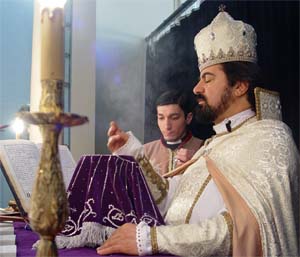 The day is even more glorious today
(Sunday). Fr. Norayr (nor-rye-er) was the celebrant this morning, behind the
drawn black curtain at the Cathedral of the Catholicosate, Deacon Berj was the
proto (or first) deacon for the liturgy which, he tells me, is something of a
rarity, given that his fine tenor voice and choral direction skills take him
more often to the choir loft than the sanctuary. Deacon Christopher once again
agrees to take photos for me, and he also takes a short movie with Fr. Norayr
singing, just after the words of consecration, “Yév uzkooys i koyotz kéz
madootranémk usd aménayni yév haghaqus aménétzoon.” … “And thine, of thine own,
unto thee we offer from all and for all.”
Click here, to
see this short movie.
The day is even more glorious today
(Sunday). Fr. Norayr (nor-rye-er) was the celebrant this morning, behind the
drawn black curtain at the Cathedral of the Catholicosate, Deacon Berj was the
proto (or first) deacon for the liturgy which, he tells me, is something of a
rarity, given that his fine tenor voice and choral direction skills take him
more often to the choir loft than the sanctuary. Deacon Christopher once again
agrees to take photos for me, and he also takes a short movie with Fr. Norayr
singing, just after the words of consecration, “Yév uzkooys i koyotz kéz
madootranémk usd aménayni yév haghaqus aménétzoon.” … “And thine, of thine own,
unto thee we offer from all and for all.”
Click here, to
see this short movie.
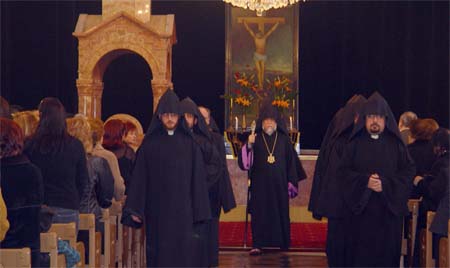
The Catholicos returned to Antelias last weekend, following nearly a month away to attend the Assembly of the World Council of Churches in Brazil. It is very good to have him home again. The Catholicosate seems somewhat empty without him, and there has been a steady flow of activity since his return — including visits from the Armenian and US ambassadors. At the close of each liturgy, the Brotherhood gathers to escort the Catholicos back across the great courtyard from the Cathedral to his official residence; and you just might recognize the “slightly” balding head, third back on the left line of monks.






